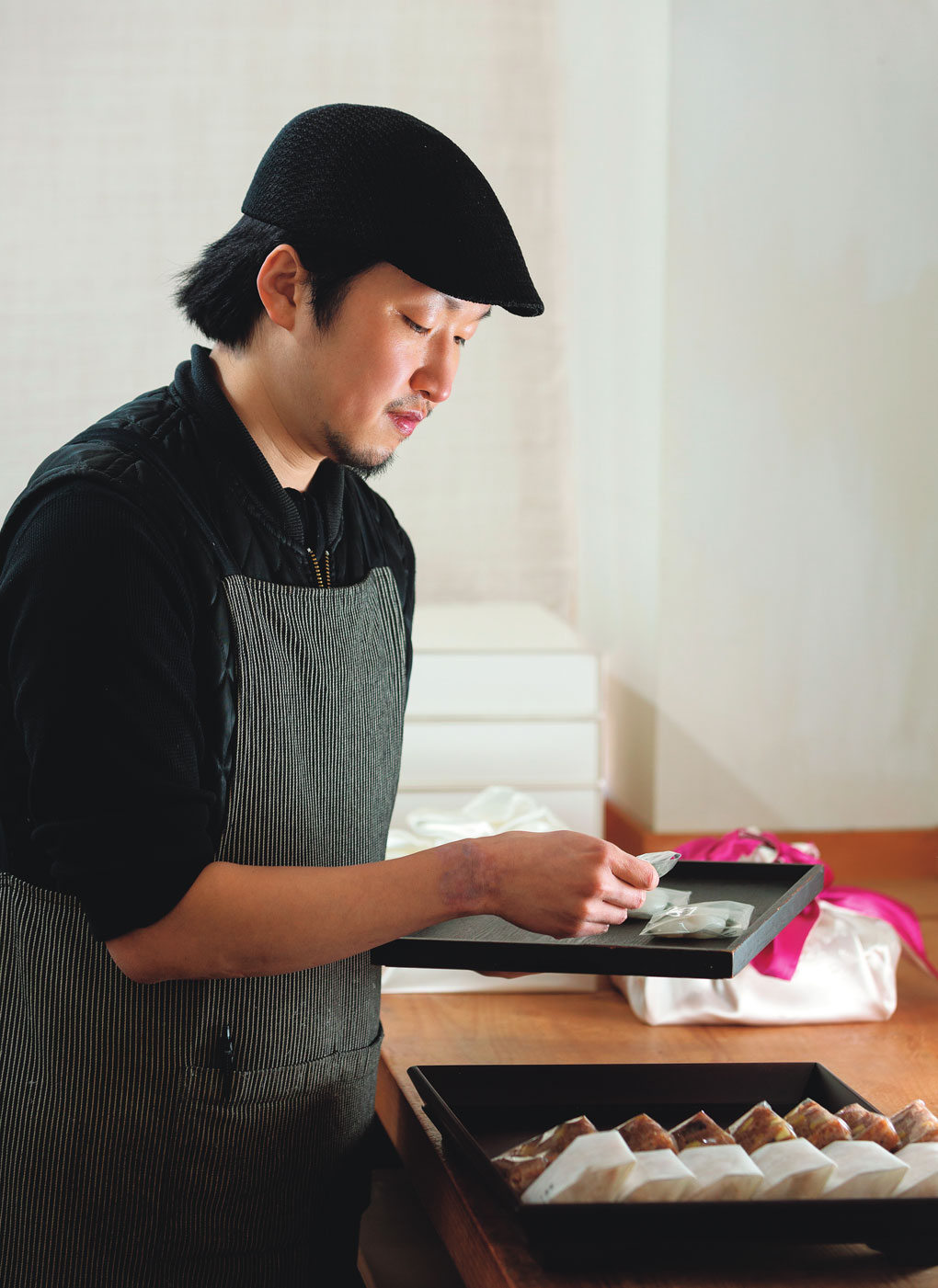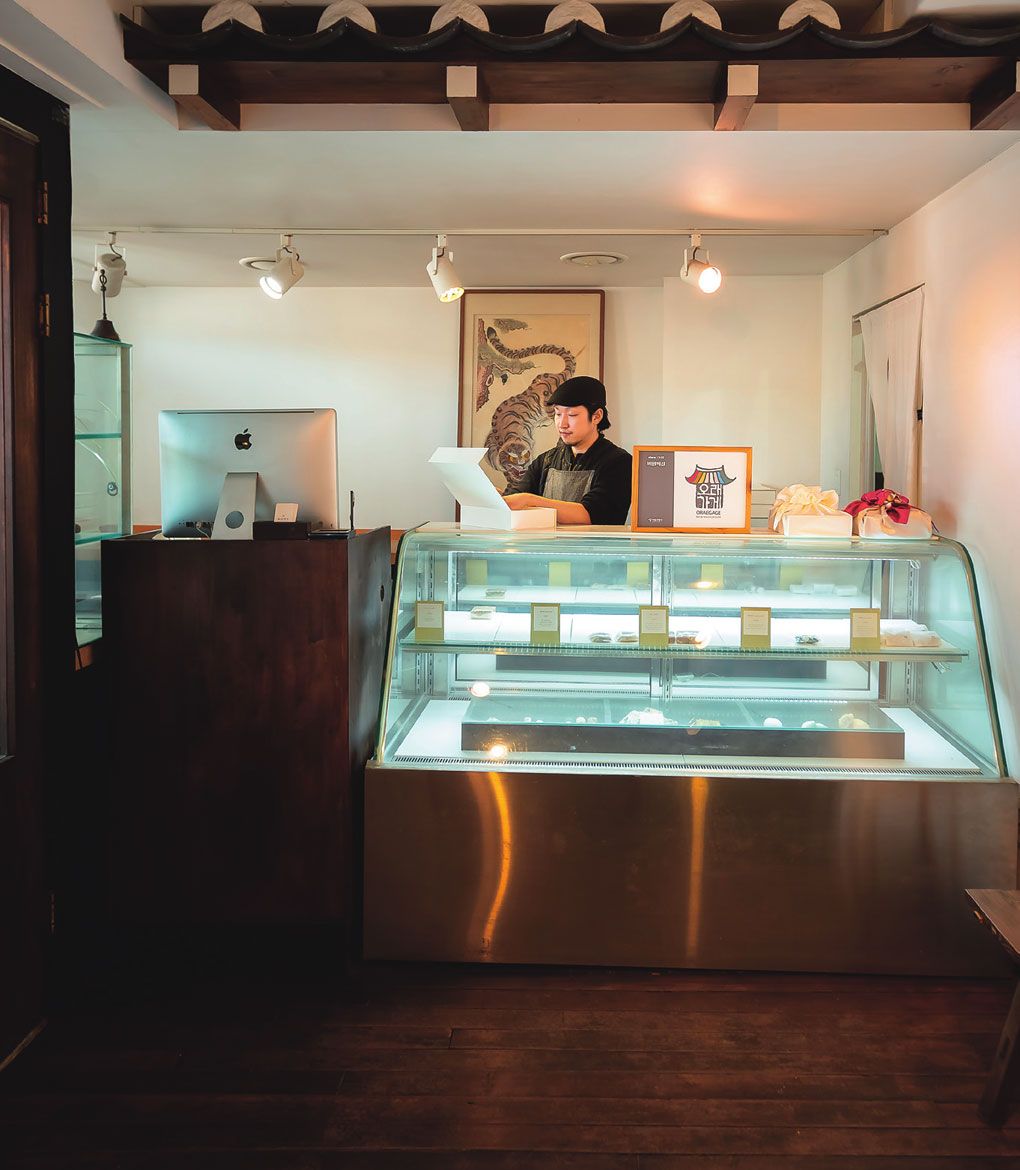Located near Gyeongbok Palace in the old city center of Seoul, Biwon Tteokjip is a rice cake shop known for its royal court recipes handed down from Joseon, the last Korean monarchy. Ahn Sang-min, the third-generation owner of this 70-year-old shop, is quietly preserving the taste of age-old delicacies.

Ahn Sang-min, third-generation owner of the 70-year-old shop Biwon Tteokjip, took over operations from his father eight years ago. Although he changed the shop’s logo and packaging to add a modern touch, he sticks to the traditional ways when making rice cakes.
The shop had no sign on the facade, its nature barely implied by a humble, eaves-shaped overhang at the front window. The same roof-tile decoration was also found inside, high up on the wall above the showcase; the shop’s atmosphere, reminiscent of the hall in a traditional hanok, was underscored by the wooden doors and floor. The showcase featured five kinds of rice cakes neatly arranged side by side.
What first caught my eye was the duteoptteok, the shop’s signature item. This glutinous rice cake is stuffed with chopped walnuts, chestnuts, pine nuts and jujubes, all mixed with yuja (citrus junos) extract, honey and cinnamon powder. Once stuffed, the rice dough is shaped into a ball and sprinkled with roasted red bean powder before being steamed. Presumably made for the first time during the Goryeo period (918-1392), this type of rice cake was a luxurious snack enjoyed by the wealthy upper class and also served on the birthday banquet table of the kings of the Joseon Dynasty (1392-1910). A gentle bite into a piece generously frosted with red bean powder gives you the rich flavor of crispy nuts followed by the sweet and tangy taste of yuja extract. Not many rice cake shops can properly produce this dainty snack, which is complicated to make and requires expensive ingredients.
In 2017, the city of Seoul introduced a program to support shops of historical value by designating them “Old Stores” (Orae Gage). As one of these Old Stores, Biwon Tteokjip (“Secret Garden Rice Cake Shop”) has enjoyed considerable media spotlight. Many articles describe the store’s origin as follows:
“Han Hui-sun (1889-1972), one of the last court ladies of Joseon, who supervised the palace kitchen during the reigns of King Gojong (r. 1863-1907) and King Sunjong (r. 1907-1910), handed down the royal rice cake recipes to Hong Gan-nan (1925-1999). Hong opened Biwon Tteokjip in 1949, and in 1984, bequeathed the shop to her nephew Ahn In-cheol, who had worked there since the 1970s.”
Royal Recipes
The shop is now run by Ahn Sang-min, the third-generation proprietor, who took it over from his father eight years ago. The junior Ahn began learning the craft 14 years ago, when he was 23 years old. While I interviewed him, he was busy going back and forth between the kitchen and the hall. Asking him how his great-aunt had learned her skills and recipes from Joseon’s last court lady, I anticipated an enthralling story. But his reply was stark and simple: “That’s all I ever heard about it from my father. I don’t think my great-aunt told him the details.”
Few of my questions succeeded in getting a longer answer. Ahn said he was reticent by nature. When I asked him what he did and did not know about the craft after devoting himself to it for 14 years, he was as laconic as ever: “There’s nothing I can’t manage on my own. My father has left everything in my charge.” As to whether there was any skill he found hard to master however he tried, he replied, “No, nothing at all.” I finally elicited a somewhat detailed answer when I inquired if his father was any better than him at the job.
“Hardly. I think I’m better than my father,” he said. “I changed the texture of our rice cakes a little, which brought increased sales and a favorable response. For instance, our earlier seolgi [fluffy rice cake steamed in a mold] was tougher and chewier than the current version, which has a lighter texture similar to pound cake.”
When I asked if he had been taking young people’s tastes into account, he said no, his own tastes guided him. Then I wondered what this young proprietor considered to be the qualities of good rice cakes.
His replies were consistently devoid of any desire to glorify his job. He mentioned no plans for a fancy menu developed in collaboration with bakeries, or of a dessert café combining classical and contemporary styles.
Texture Matters Most

The roof-tile decorations on the ceilinga traditional atmosphere inside the store. In 2017, the place was designated by the city of Seoul as an “Old Store,” a title conferred to shops of historical value in the city.
“Well, there are a number of conditions, but it would be texture that matters most – in other words, texture determines the taste. You need the right texture and chewiness for each variety of rice cake. There’s really nothing else,” he said. And what factors affect the texture? “The fineness or coarseness of the rice flour and the amount of water and salt. The texture is influenced most by the particle size of the rice flour. Depending on how fine or coarse, a product might be tough or nice and chewy, either hardens quickly or remains soft longer. I think about these things a lot.”
Ahn changed not only the texture of the rice cakes but also the look of his products and of the shop itself. As most of his patrons were regulars, he tried to find ways to attract new customers, particularly younger people in their 20s and 30s. First, he got rid of the old packaging, which used plastic film tightly wrapped around rice cakes ed on crude Styrofoam plates. Instead, he began wrapping each piece individually, and then he redesigned the store logo and packaging, following the example of famous bakeries. He also started offering gift sets – assortments of rice cakes contained in white paper boxes. As a result, younger customers came to account for some 30 percent of sales.
None of the current proprietor’s changes have compromised the essence of the flavor handed down in the family. As far as his work is concerned, Ahn seems quite confident and free of anxiety in running a shop that has provided the same products made in the same way every day for over 70 years. His is a craft of producing something perishable – a craft polished for decades, refined and proven by patrons’ tastes. He has the relaxed manner of a person who knows what he’s doing. It was reassuring to hear that he continued to use high-quality local ingredients, just as his father had. Would cost cutting on any of the ingredients mean a change in taste? I asked. He looked a little puzzled, and then said, “Probably. But I actually have no idea because I’ve stuck to the same ingredients since my father’s days.”
When I asked what he found to be the hardest part of making duteoptteok, which requires more than a dozen ingredients to be properly mixed, he paused for the first time before answering. He finally said, “I don’t know what is hard or what is easy. I’ve never learned to make rice cakes anywhere else. I’ve only worked here, so I can make no comparisons. I’m not sure how to answer that.”
Ahn grew up looking at things through the vapor rising from the steamers in the shop’s kitchen. He had always felt sorry for his father, who would spend hours on end in front of the pot roasting the red bean powder to be sprinkled on the duteoptteok. That’s when he decided to take over. His only goal was to add value to the job, which brought puny rewards compared to the amount of work it required. Immediately after his discharge from military service, he started to work all day, beginning at three or four in the morning. He put aside college education, in which he’d had little interest anyway.

1.Two pieces of stuffed rice cake are put together in the shape of human lips to make ssang gaepitteok. The stuffing, which is made of red beans peeled, boiled and mashed, is wrapped in rice dough.
2.To make yaksik, soaked sticky rice is steamed, then mixed with honey, raw sugar and soy sauce to color it brown. Halved chestnuts, dried and quartered jujubes and sesame oil are added, and the mixture is steamed again and garnished with pine nuts.
3.The store’s signature item duteoptteok is Ahn’s favorite. A bite into a piece covered with fine red bean powder gives you the luxuriant flavor of chopped nuts and sweet citrus junos extract.
Everyday Rituals
Gradually, he settled into the daily routine of the shop that would become the only place in the world over which he had complete control.
“What has been the hardest part of this work so far?” I asked again.
“Nothing really, except that my family spends all day working here together, so we sometimes bicker over little things,” he said.
“Now that you have the shop on the right track, do you ever feel complacent or bored with the repetitive routine?” I tried from a different angle.
“Such a thought has never entered my mind,” he replied.
“Do you have any master plan for this shop?” I tried again.
“Not really. I’ll just keep doing what I’ve been doing,” he said.
His replies were consistently devoid of any desire to glorify his job. His shop has become well-known through media coverage, but he mentioned no plans for a fancy menu developed in collaboration with bakeries, or a dessert café combining classical and contemporary styles. On the contrary, he said he might reduce the variety of items on sale to concentrate on some of the more important types.
I wondered why I felt unsatisfied with his answers. Then I realized that I’d expected him to fit my preconception that a young leader of a generations-old family business should reinterpret tradition and innovate. With this realization, my eyes finally opened to what was in fact a person’s ordinary day – a day with nothing special about it. A simple life where his days begin and end in the same shop, just like his father’s; where he works late when there’s a rush of orders, or happily closes up early when the shelves are empty. His modest attitude, with which he doesn’t compare his life with that of other professionals, calmly carrying out his tasks for today and welcoming tomorrow rather than fretting over the unknown days far ahead.
As I left the shop, something seemed to spill out of the wooden door, which had grown glossy with time. It was the precious consistency of daily life, alive in every corner of the world but rarely receiving its proper share of attention. The untiring rhythm of a plain life, never particular but beautiful.